
CBSE Class 12 Biology Sample Paper 2023-24: Students pursuing the medical stream in Class 12 are well aware of the significance of mastering the concepts in the Class 12 Biology subject. The topics covered in the CBSE Class 12 Biology book hold immense importance not only for the Class 12 board exam but also for medical entrance exams like NEET UG.
Therefore, it is important for students to prepare for the Biology subject with full dedication. Recognizing the importance of this subject for medical aspirants, CBSE has released sample papers for the Biology subject providing valuable practice material to help students in their preparation.CBSE Class 12 Biology Sample Paper 2023-24
The CBSE Class 12 Biology Sample Paper 2024 for the new academic term has been released by the Central Board of Secondary Education (CBSE) on its official website. In this article, we provide direct download links for students to access the CBSE Class 12 Biology Sample Paper 2024 and prepare effectively for their Class 12 science stream exams.CBSE Biology Previous Year Question Paper Class 12
CBSE Class 12 Sample Paper Biology 2023-24 PDF
You can access the CBSE Class 12 Sample Paper for Biology 2023-24 through the provided PDF link. This sample paper is really helpful for students preparing for their Class 12 Biology exams. It gives a good idea of what the exam will be like and includes detailed answers to help you understand the material better.CBSE Class 12 Sample Paper Biology 2023-24 PDF
CBSE Class 12 Biology Sample Paper 2024 Exam Pattern
The CBSE sample papers is the best resources that closely resemble the actual exam paper. These official sample papers provide detailed information about the marking scheme and exam pattern. The CBSE Class 12 Biology Sample Question Paper consists of five sections. Some important features of the CBSE Class 12 Biology Sample Paper PDF include: (i) All answers are mandatory. (ii) The question paper is divided into five parts, containing a total of 33 questions. All responses are required. (iii) Section A comprises 16 questions, each worth one point; Section B has 5 questions, each worth two points; Section C includes 7 questions, each worth three points; Section D contains two case-based questions, each worth four points; and Section E consists of three questions, each worth five points.CBSE Sample Papers for Class 12 Year Wise PDF Download
(iv) There is no overall option provided. However, internal choices are available for some questions. In such cases, students must attempt only one of the alternatives. (v) Students should make neatly labeled diagrams wherever possible.CBSE Class 12 Biology Chapter-Wise Weightage 2023-24
CBSE Class 12 Sample Paper Biology 2023-24 With Answers
Section A: Objective Type Questions (1 mark each)
1. Remnants of nucellus are persistent during seed development in:
a) pea b) groundnut c) wheat d) black pepperAnswer: d) black pepper
2. The wall layer of microsporangium which nourishes the pollen grain is:
a) epidermis b) endothecium c) middle layers d) tapetumAnswer: d) tapetum
3. A short piece of DNA, having 20 base pairs, was analyzed to find the number of
nucleotide bases in each of the polynucleotide strands. Some of the results are
shown in the table.
| Adenine | Cytosine | Guanine | Thymine |
|---|---|---|---|
| Strand 1 | 4 | 4 | - |
| Strand 2 | - | 5 | - |
Answer: d) 7
4. In a certain species of insects, some have 13 chromosomes, and the others have 14chromosomes.The 13 and 14 chromosome bearing organisms are
a) males and females, respectively b) females and males, respectively c) all males d) all femalesAnswer: a) males and females, respectively
5. At a particular locus, the frequency of allele A is 0.8 and that of allele a is 0.2. What would be the frequency of heterozygotes in a random mating population at equilibrium?
a) 0.32 b) 0.16 c) 0.24 d) 0.48Answer: a) 0.32
6. Variations caused due to mutations are
a) random and directionless b) random and directional c) random and small d) random, small and directionalAnswer: a) random and directionless
7. What is the smallest part of a DNA molecule that can be changed by a point mutation?
a) Oligonucleotide b) Codon c) Gene d) NucleotideAnswer: d) Nucleotide
8 . What should be the genotype of the indicated member?
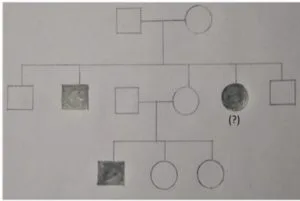 a) AA
b) Aa
c) XY
d) aa
a) AA
b) Aa
c) XY
d) aa
Answer: d) aa
9. A patient was advised to have a kidney transplant. To suppress the immune reaction, the doctor would administer him:
a) statins produced from Monascus purpureus b) statins produced from Streptococcus thermophilus c) cyclosporin A produced from Trichoderma polysporum d) cyclosporin A produced from Clostridium butylicumAnswer: c) Cyclosporin A produced from Trichoderma polysporum
10. Identify the activity of endonuclease and exonuclease in the given image.
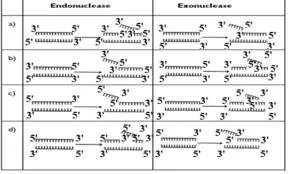
Answer: (d)
11. The main objective of the production of pest-resistant GM crops is to
a) encourage eco-friendly pesticides b) reduce pesticide accumulation in food chain c) eliminate pests from the field without the use of manual labour d) retain maximum nutritional content in the crop that would be otherwise consumed by pestAnswer: b) Reduce pesticide accumulation in food chain
12. Observe the contents 1,2,3 and 4 of soil samples A,B and C shown in the graph. If the temperature and soil moisture of all soil samples are identical, which soil sample (s) will show faster decomposition?
a) Soil Sample A b) Soil Sample B c) Soil Samples A and B both d) Soil Sample CAnswer: d) Soil Sample C
Questions No. 13 to 16 consist of two statements – Assertion (A) and Reason (R). Answer these questions selecting the appropriate option given below:
a) Both A and R are true and R is the correct explanation of A. b) Both A and R are true and R is not the correct explanation of A. c) A is true but R is false. d) A is false but R is true.13 Assertion: Primary endosperm nucleus is diploid.
Reason: It is the product of double fertilization.Answer: d) A is false but R is true
14. Assertion: Ribosomal RNA is synthesized in the nucleus of the cell.
Reason: It is translated with the enzyme RNA polymerase III.Answer: c) A is true but R is false
15. Assertion: Smoking can raise blood pressure and increase heart rate.
Reason: Nicotine stimulates adrenal glands to release adrenaline and noradrenaline into the blood circulation, both of which raise blood pressure and increase heart rate.Answer: a) Both A and R are true and R is the correct explanation of A.
16. Assertion: PCR is a powerful technique to identify genetic disorders.
Reason: PCR can detect mutations in low amounts of DNA.Answer: a) Both A and R are true and R is the correct explanation of A.
Section B: Short Answer Questions (2 marks each)
17. Explain the process of hormonal regulation of spermatogenesis.
18. The diagram below shows the sequence of amino acids in part of a haemoglobin
molecule.
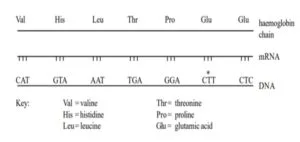 a) If the base T* was substituted with A, how would it affect the hemoglobin
chain?
b) Name the condition and the effects associated with the above substitution.
a) If the base T* was substituted with A, how would it affect the hemoglobin
chain?
b) Name the condition and the effects associated with the above substitution.
19. The graph given below indicates the administration of the first (L) and second dose (M) of a vaccine. The corresponding response of the body is indicated by X and Y. Interpret the graph and explain the reason for such a response shown by the body.
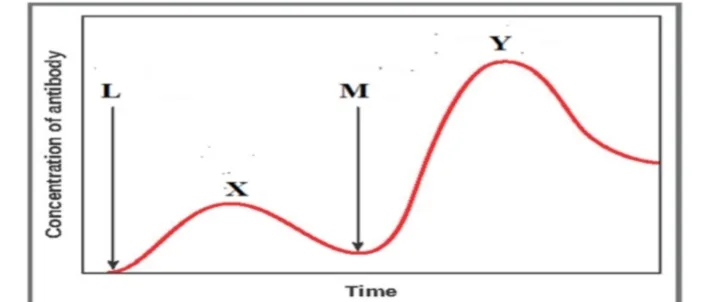
20. The image below shows the result of plating bacteria in chromogenic medium after incorporating the gene of interest in plasmid. Some plates had blue colonies; some plates had white colonies. A single bacterium extracted from Plate I,II,III is shown below:
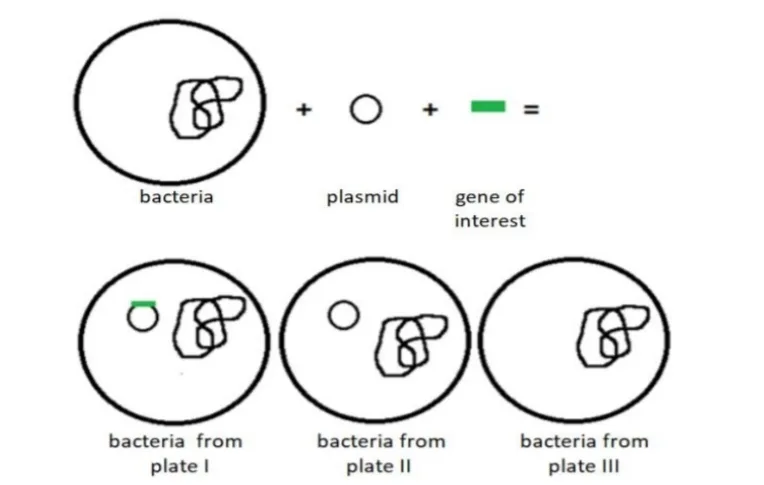 On the basis of your observations
a) Identify the plate(s) which is/are white. Give a reason.
b) Identify the plate(s) which is/are blue. Give a reason.
On the basis of your observations
a) Identify the plate(s) which is/are white. Give a reason.
b) Identify the plate(s) which is/are blue. Give a reason.
21. Biomass of a standing crop of phytoplankton is 4 kg/m2 which supports a large standing crop of zooplankton having a biomass of 11 kg/m2. This is consumed by small fishes having a biomass of 25 kg/m2 which are then consumed by large fishes with a biomass of 37 kg/m2.
Draw an ecological pyramid indicating the biomass at each stage and also name the trophic levels. Mention whether it is an upright or inverted pyramid. OR Use the information provided in the table given below to answer the following questions: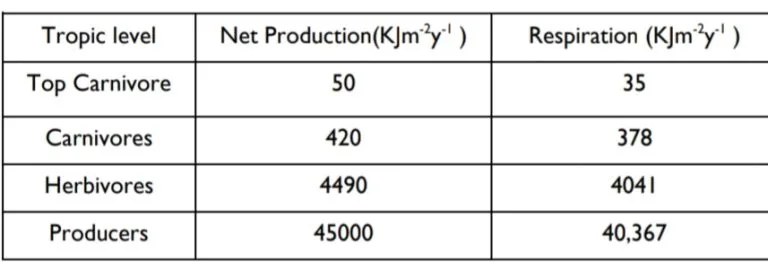 a) Calculate the gross primary productivity.
b) Analyze the trend in the Net Production from Producers to Top
Carnivore. Give a reason for your observation.
a) Calculate the gross primary productivity.
b) Analyze the trend in the Net Production from Producers to Top
Carnivore. Give a reason for your observation.
Section C: Long Answer Questions (3 marks each)
22. The figure given below shows 3 sperms A, B and C.
a) Which one of the three sperms will gain entry into the ovum? b) Describe the associated changes induced by it on P and Q.
23. Explain the phases in embryonic development from the morula stage till the establishment of pregnancy in a human female.
24. A pregnant human female was advised to undergo MTP. It was diagnosed that the fetus she was carrying had developed from a zygote having 45 chromosomes with only one X chromosome.
a) What is this condition called and how does it arise?
b) Why was she advised to undergo MTP?
25. The graphs below show three types of natural selection. The shaded areas marked with arrows show the individuals in the population who are not selected. The dotted vertical lines show the statistical means.
 a) What names are given to the types of selection shown in graphs A, B
and C.
b) After the selection has operated for several generations in the above
populations indicated as Graph A, B and C, graphically illustrate the probable
results.
a) What names are given to the types of selection shown in graphs A, B
and C.
b) After the selection has operated for several generations in the above
populations indicated as Graph A, B and C, graphically illustrate the probable
results.
26. The aeration tank of a sewage treatment plant is not functioning properly. Explain in detail the impact of this on the treatment of sewage and BOD of the effluent.
27. A farmer grew 2 varieties of corn crop in field A and B. He grew normal corn crops in field A and GM corn crops in field B. He observed corn borers attacked only in field A. To control it, spores of Bt were sprayed in field A.
a) Name the gene in the spores responsible for the control of this pest. b) What effect will the spores of Bt have on the insect pest? c) How has field B developed resistance against this pest? OR Lipoprotein lipase deficiency (LPLD)is a genetic disorder in which a person has a defective gene for lipase. This leads to high triglycerides, stomach pain, and fat deposits under the skin. It may eventually affect the liver, and pancreas and may also cause diabetes. The disorder occurs if a child acquires defective genes from both parents (autosomal recessive). ERT (enzyme replacement treatment) is one of the treatments offered to patients with LPLD. a) (i) What procedure is followed in ERT? (ii) What could be one possible drawback of ERT? b) How can LPLD be treated using Biotechnology? Elaborate.28. Give three reasons as to why the prokaryotes are not given any figures for their diversity by the ecologists.
Section D: Case-Based Questions (Each Question 4 Marks)
Q. No. 29 and 30 are case-based questions. Each question has 3 subparts with internal choice in one subpart.
29. The structure below shows pUC18 which is similar to pBR322 in its function. However, they differ in some of their restriction sites and number of ori. The ori number for pBR322 is approximately 20.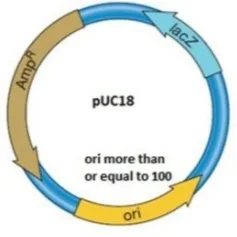 a) How are puc18 and pBR322 used in biotechnological studies?
OR
What will be the impact if oriin the above structure gets damaged?
b) The lac z gene has many recognition sites. Study the segment of DNA given below and answer the questions
5’… ATC GTA AAG CTT CAT…3’
3’… TAG CAT TTC GAA GTA…5’
i) Applying your knowledge of palindrome sequences identify and mark the possible region where the restriction enzyme X will act.
ii) Restriction enzyme Y was used to extract gene of interest from a plant. This gene needs to be inserted in the given DNA segment which has been treated with restriction enzyme X. Will there be successful recombination? Explain with a reason.
c) Which one of the two (pUC18 and pBR322) would you prefer for biotechnological studies? Justify.
a) How are puc18 and pBR322 used in biotechnological studies?
OR
What will be the impact if oriin the above structure gets damaged?
b) The lac z gene has many recognition sites. Study the segment of DNA given below and answer the questions
5’… ATC GTA AAG CTT CAT…3’
3’… TAG CAT TTC GAA GTA…5’
i) Applying your knowledge of palindrome sequences identify and mark the possible region where the restriction enzyme X will act.
ii) Restriction enzyme Y was used to extract gene of interest from a plant. This gene needs to be inserted in the given DNA segment which has been treated with restriction enzyme X. Will there be successful recombination? Explain with a reason.
c) Which one of the two (pUC18 and pBR322) would you prefer for biotechnological studies? Justify.
30. Observe the graph given below.
The graph represents inter-specific interaction between two species of Paramecia competing for the same resource in a culture medium. Paramecium caudatum and Paramecium aurelia were grown in separate cultures as well as in mixed cultures. It was found that each species grew in numbers according to the logistic equation.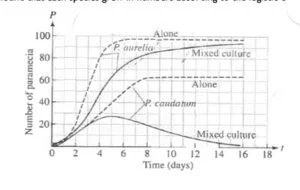 a) Which species is competitively superior? Support it with the data provided in the graph.
b) State the underlying principle for the above result and name the scientist associated with this principle.
c) Explain the mechanism in which two or more species competing with each other can co-exist.
OR
Graphs A and B shown below depict the interaction of two species. Which graph indicates Mutualism? Give reason.
a) Which species is competitively superior? Support it with the data provided in the graph.
b) State the underlying principle for the above result and name the scientist associated with this principle.
c) Explain the mechanism in which two or more species competing with each other can co-exist.
OR
Graphs A and B shown below depict the interaction of two species. Which graph indicates Mutualism? Give reason.
Section E: Detailed Answer Questions (Each Question 5 Marks)
31 Placed below are case studies of some couples who were not able to have kids. These couples are not ready for adoption or taking gametes from donors. After thoroughly examining the cases, which Assisted Reproductive Technology will you suggest to these couples as a medical expert? Explain briefly the justification of each case.
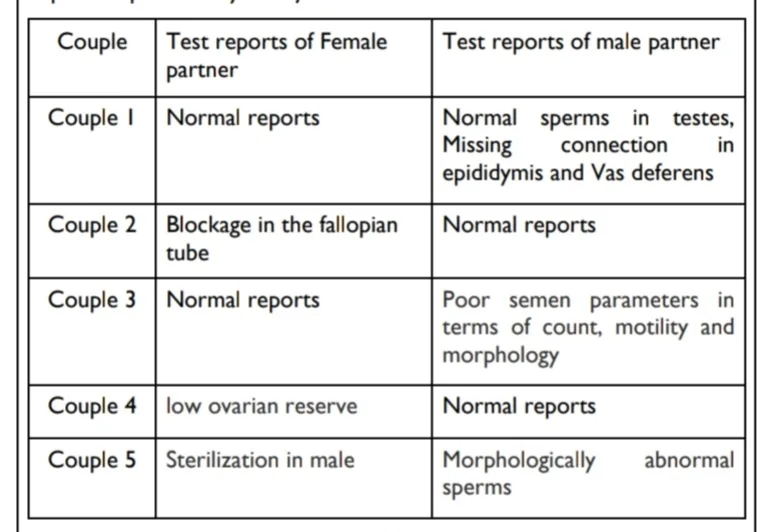 OR
Given below are certain situations. Analyze the situation and suggest the name of a suitable contraceptive device along with the mode of action.
OR
Given below are certain situations. Analyze the situation and suggest the name of a suitable contraceptive device along with the mode of action.
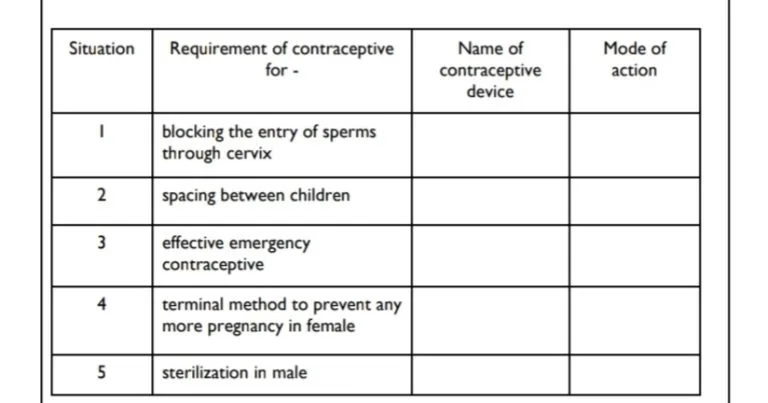
32. Given below is a stretch of DNA showing the coding strand of a structural gene of a transcription unit.
5’–ATG ACC GTA TTT TCT GTA GTG CCC GTA CTT CAG GCA TAA—3’ a) Write the corresponding template strand and the mRNA strand that will be transcribed, along with its polarity. b) If GUA of the transcribed mRNA is an intron, depict the sequence involved in the formation of mRNA /the mature processed hnRNA strand. i. In a bacterium ii. In humans c) Upon translation, how many amino acids will the resulting polypeptide have? Justify. OR In shorthorn cattle, the coat colors red or white are controlled by a single pair of alleles. A calf that receives the allele for red coat from its mother and the allele for white coat from its father is called a ‘roan’. It has an equal number of red and white hairs in its coat. a) Is this an example of codominance or of incomplete dominance? b) Give a reason for your answer. c) With the help of genetic cross explain what will be the consequent phenotype of the calf when i. red is dominant over white ii. red is incompletely dominant.33. Explain the role of Primary and Secondary Lymphoid organs with the help of suitable examples.
OR With the help of a flow chart illustrating how an infected animal cell can survive while viruses are being replicated or released.CBSE Class 12 Biology Sample Paper 2023-24 FAQs
What is the CBSE Class 12 Biology Sample Paper?
How should I use the CBSE Class 12 Biology Sample Paper for preparation?
Are the questions in the CBSE Class 12 Biology Sample Paper based on the latest syllabus?










